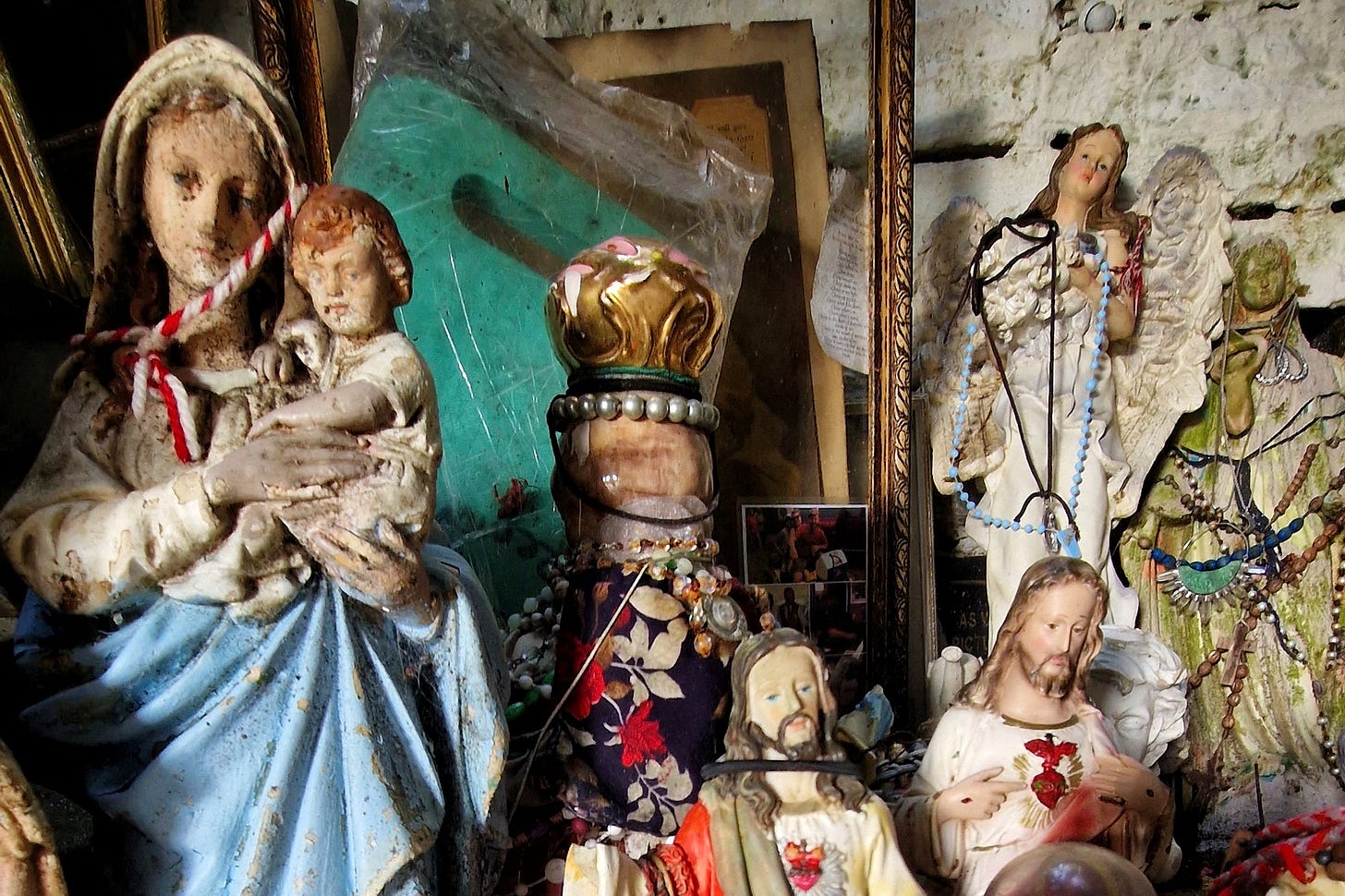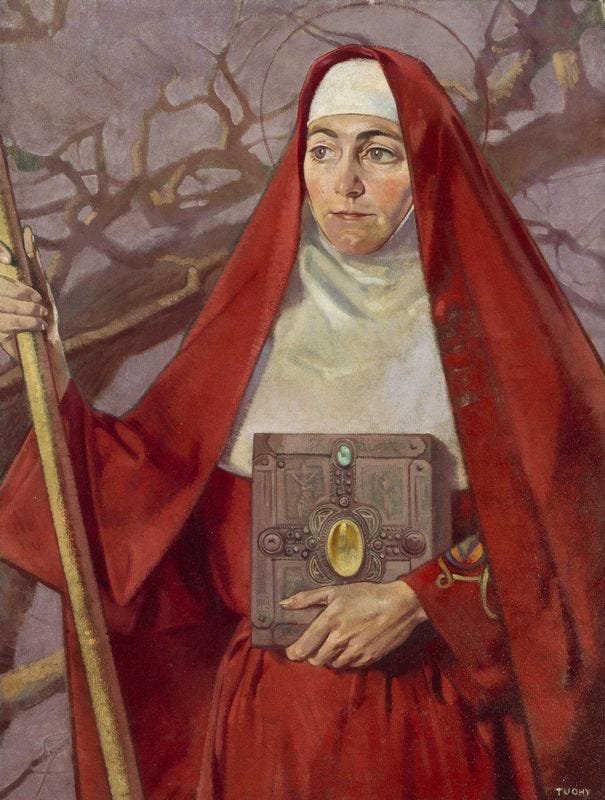Hello, Imblog sona duit, and welcome to my newsletter, which I’ve named Splinister.
Er…imbolg what now?
Imblog sona duit is the Irish for Happy Imbolg to you. Imbolg (or Imbolc) was an important calendar event in Ireland. The translation for it comes from ‘in the bag’ or ‘in the belly’ because it occurred during the lambing season. It’s a dark and frosty period, so the bleating of lambs would be a happy sound, heralding the coming spring.
Under our modern calendar it’s celebrated on the 1st of February, and there is some thought that back in the day (just a thousand years or so) the Irish marked sunset as the start of the day. I find this an intriguing view on life: you endure the vigil in darkness before the sunset. Doubt crowds us before the liberation of dawn.
Imbolg is associated with the Irish Goddess Brigit (Brigid or Bríd, whose name means ‘the exalted one’), whose province is poetry, healing and smithing. The early Catholic Church in Ireland assimilated the aspects associated with the Goddess into the popular Saint Brigid.
Naomh, the modern Irish word that translates as saint, started as noíb, the old Irish word for holy. There’s also thought that Brigit was an honorific conferred upon different people. Much of what’s attributed to Saint Brigid (a person the Catholic Church never officially canonised) is folklore and propaganda.1 Underneath all of that is the personification of the primal force of fire that can be utilised in three ways: to power our lives, to create and to mend.
This year Ireland has introduced a new public holiday in honour of Brigit, which will be celebrated on the first Monday in February. Technically it’s referred to as St Brigid’s Day (or Lá Fhéile Bríd) since the more recent incarnation of the exalted one is being honoured. Thus most Irish workers are looking forward to the coming long weekend, now dedicated to a multi-faceted Goddess.
I liked this connection between gestation, birth and creativity, and decided to launch my revamped newsletter this evening.

What is Splinister?
It’s the username I created back in 2004, and its genesis is an amusing story, which I’ll save for another time. I’ve associated Splinister with my writing work for almost two decades, so I’m sticking with the brand.
Sidebar: let’s remember that the NXIVM cult was busted partly because it encouraged important members of the organisation to be branded with the initials of its leader. Now, whenever I read writers and influencers discussing branding, I get the whiff of seared flesh.
Here’s a terrific podcast from the CBC about NXIVM. I have a fascination with cults, the people who run them, and those attracted to them, but I’m sure I’ll get to that in another newsletter.
I contemplate branding and being a writer quite a bit – it’s inevitable in the mediascape – but I’ll park this topic for exploration later.
Substack allows me to hive off newsletters for specific topics, so I can consider that route in the future if I develop a passion for a niche subject.
What’s more interesting to me is the ability to include video and audio, as well as having paid options. For now, this Substack is free. As this space develops, I’ll consider the subscription options for extra content.
Finally, Substack emphasises words, not fancy formatting and pretty fonts. The style choices available are minimal, which is a good thing for a missive that is being send to people’s busy inboxes.
I will admit to being a bit of a design junkie. I can lose hours of my day messing around with graphics and fonts, so it’s to my benefit that Substack hands me these basic tools in the manner of an experienced, dusty carpenter and adds, rather gruffly, ‘That’s all you need’.
What will you discuss?
I’ll be writing about subjects that interest me, including art, music, writing, cinema, mythology, history, technology, science and philosophy. I’ll refer to my own work at times too. I’ve little to say about politics or world events and will be keeping out of those troubled waters. There are better analysts than me on those complicated issues, and plenty of them write on Substack.
How often will you write a newsletter?
I’m going for a fortnightly schedule to start, monthly at a minimum. Newsletters will vary in length, but I will aim not to bore you!
Why now?
Life is all about adaptation. If something is no longer working, then you need to stop and try something new. And you need to challenge yourself to deepen existing skills. So this is an experiment of sorts.
It’s also driven by a need to have a space in which I can get thoughts out of my head and explore them properly. Many of my daily ponderings are not about my latest bit of work, but about articles I’ve read, films/TV I’ve watched, or a deep dive podcast (see above).
Back in the 2000s I used to blog regularly, and I wrote about whatever struck my fancy. That died off as social media proliferated, and the spaces I inhabited (such as Twitter) became riven. Now, I mainly use my blog to mention projects that are happening or in process.
Sidebar: I started blogging back in the late 1990s, when I was working full time in IT in Dublin as a systems administrator. My first blog was focused on technology – it was among the initial tranche of blogs in Ireland. I remain pretty geeky and keep up with technology and science trends as best I can.
So, why don’t you just return to using your blog?
Times have moved on. Substack has what I require for this era. That may change again in the future, it’s probably inevitable. I’ve watched so many tech evolutions at this point that the only thing I can predict is that it will transform again.
Why you, why now, why your opinion?
Woah, steady on fictional interviewer!
These are perennial questions, seeded in the darkness of self-doubt, which plague every writer. I have been asking them my entire life, and they hampered all my original attempts to write. When I finally started writing consistently it was via blog posts, and that practice gave me the confidence to tackle fiction.
I’d forgotten about this career trajectory until I took an online class in memoir writing last year, and I read several posts from my tech blog era. I recognised in them that spark, that need to communicate about subjects that preoccupied my mind.
For the last ten years I’ve bottled up all those thoughts and stuck to writing fiction (and some nonfiction) for various markets. Recently I understood it would be beneficial to my writing to have an outlet for my interests. As much as I love imagining and writing fictional universes, I’m also invested in this world we share. If anything, I believe we are at a turning point where engaging communication about topics that grip us are more important than ever.
I hope you’ll tag along on my journey in remembering why I started all of this in the first place. That I was first driven to turn my thoughts into pixels and display them on the Internet where anybody could read them on their screens. It’s both a brazen and delusional act.
But that is at the core of all art. We do it hoping an audience will appreciate it, but that is never guaranteed. We do it because we are driven to do it. I learned long ago to honour that need, even if I still struggle with how I go about it.
For to reject that creative impulse is to reject the self.
And that’s worse that being rejected by an editor, a publisher, or bots on the Internet. They go away when the screens turn off.
I must reckon with myself at 3am in the dark.
Then In the morning I rise, renewed, and set my thoughts in order.
So, I salute you as the darkness reigns, and thank you, kind reader!
The sun will rise tomorrow, and so will your spirits.
Welcome to Splinister!
Sidebar redux: watch a short clip of the English sculptor Phyllida Barlow discussing the heroic nature of creating art that no one sees. She believes its positive contribution to the creator and the world remains felt on some level. I hope you find it as inspiring as I did.
There was an important ecclesiastical centre established in Kildare, Ireland around 470 AD by a nun, Brigit, who died in 524 AD. She must have been an extraordinary woman, as she founded, and led, a double monastery for men and women which pioneered monastic life in Ireland. She was a member of the important Fotharta sept, and with astute and political manoeuvring, they did a terrific job of promoting her legend before and after her death. She is often considered the ‘Irish Mary’, and the Fotharta did much to tie their tribeswoman to aspects of the mother of Jesus. Our first written reference about her dates from around 600 AD, so there is nothing within her lifetime. Much of what has sprung up since is an accumulation of folklore and myth, scattered with imprecise remembrances, yet clearly she was an important figure who made a large cultural contribution. There is a gorgeous tribute garden and centre to the Goddess/Saint in my home country of Galway, and the Solas Bhríde Centre and Hermitages in Kildare re-established the Brigit connection in the area thirty years ago and is now going strong.








Loved reading this and learning about Imbolc, Saint Brigid and your blogging journey!
Nice background on Imbolc and Brigid. I've always liked this short tongue-in-cheek film about her, made shortly before the abortion referendum in 2018: https://www.youtube.com/watch?v=HG61E4-iceQ